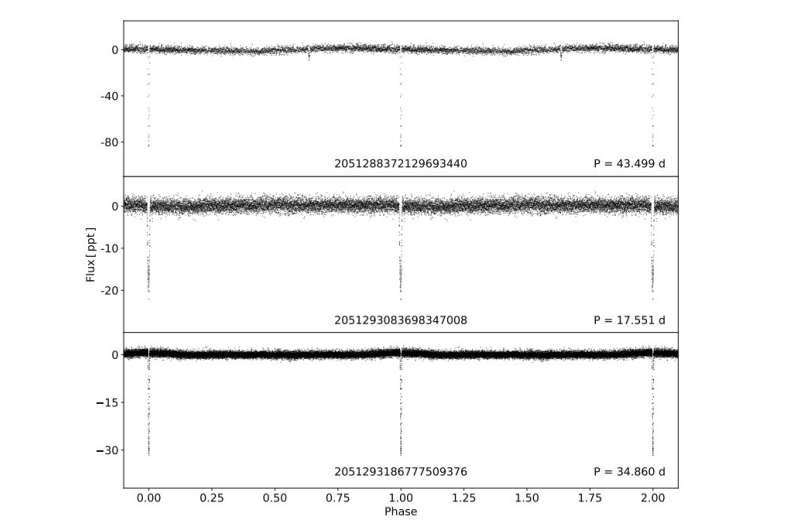Phased light curves of three newly discovered binary star members of NGC 6791. Credit: Sanjayan et al, 2023
Using data from NASA's Kepler spacecraft, astronomers from the Pedagogical University of Cracow, Poland, and elsewhere have detected 278 variable stars in the open cluster NGC 6791 and its surroundings. The finding was reported in a paper published March 13 on the arXiv pre-print repository.
Variable stars could offer important hints into aspects of stellar structure and evolution. They could also be helpful for better understanding the distance scale of the universe. In particular, studies of variable stars in star clusters are of special interest for astronomers as they have the potential to help identify systematic errors that affect stellar distance indicators.
Located about 13,300 light years from the Earth in the Lyra constellation, NGC 6791 is one of the most studied open clusters (OCs). It has an estimated age of approximately 8 billion years and an iron to hydrogen abundance ratio that is more than twice that of our sun. This makes it one of the oldest and most metal-rich clusters in the Milky Way galaxy. With a mass of approximately 4,000 solar masses, it is also one of the most massive OCs known to date.
Previous observations of NGC 6791 have found that it hosts multiple stellar populations and detected hundreds of variable stars in the cluster. Recently, a team of astronomers led by Sachu Sanjayan has analyzed the data obtained by Kepler's prolonged mission known as K2, hoping to discover more variables in NGC 6791.
"We presented a search for variable stars in the Kepler superstamp data. All available pixels were searched, by means of a Fourier amplitude spectrum, and a contiguous optimal aperture for each object that shows a significant flux variation were defined," the researchers explained.
All in all, the team identified 278 variable stars, out of which 119 turned out to be newly detected variables. Among the whole sample, 17 binaries, 45 pulsators, 62 rotational and five unclassified variables were found to be members of NGC 6791. The remaining 28 binaries, 25 pulsators, 83 rotational, four unclassified and nine unidentified variables are either not cluster members or their membership is yet to be determined.
The color-magnitude diagrams (CMDs) show that a majority of the identified variable stars in NGC 6791 are located in the main sequence. Solar-like pulsators are mostly located in the red giant branch (RGB) and red clump (RC), while semi-regular variables are located in the RGB and asymptotic giant branch (AGB). In addition there are five blue straggler (BS) and three extreme horizontal branch (EHB) stars.
The study found that the metallicity is not consistent among the identified variable cluster members. The astronomers assume that this could be due to the presence of multiple stellar populations within NGC 6791, however a uniform spectroscopic survey is necessary in order to confirm this assumption.
Based on the newly collected data, the researchers managed to derive fundamental parameters for NGC 6791. The results indicate that the cluster is 8.9 billion years old, has a metallicity at a level of 0.26–0.28, and is located some 13,500 light years away.
More information: Sachu Sanjayan et al, A variable star population in the open cluster NGC 6791 observed by the Kepler spacecraft, arXiv (2023). DOI: 10.48550/arxiv.2303.07422
Journal information: arXiv
© 2023 Science X Network
























